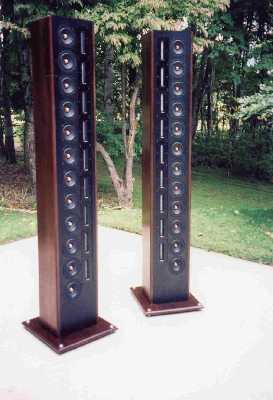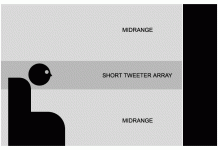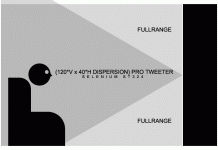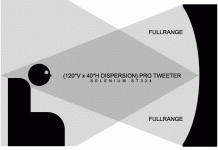Well my line array consists of 16, 4" fullrange drivers and an short array of 9 tweeters. I crossed them over at ~6k. I have an U baffle with a 10" baffle and 4" sides. After moving, I become bored and thoroughly unimpressed by these speakers. I decided to unhook the tweeters and run the 4" drivers fullrange. After boosting the high end, I fell in love with the speakers again. The sound is so spacious and live. Now all that is missing is the high frequency twinkle. I've decided to add a single Selenium ST324 to the middle. With it's sensitivity and wide dispersion I think it will work well to reinforce the highs. I was also contemplating curving the baffle. I know this will create a sweet spot. But if I were to match the arc of the baffle, with the dispersion of the tweeter, wouldn't this give me a much larger sweet spot?
Are there any pro curved line array people? I only seem to hear negatives.
This was my setup before ditching the tweeters. Please tell me why what I'm trying to do is wrong or right. Knock some sense into me if necessary
Are there any pro curved line array people? I only seem to hear negatives.
This was my setup before ditching the tweeters. Please tell me why what I'm trying to do is wrong or right. Knock some sense into me if necessary
Attachments
Pro Curved Line Array
For pro sound most line arrays are curved but in a convex (outward) matter. The arrays are curved to give better coverage for the lower level seats (mostly near field) while firing the far field over the top of those seats to the rear of the hall and the balcony. These arrays are segmented so that individual segments can be angled to achieve the desired position. Several pro sound arrays have DSP controllers that can help to optimize the angular positioning so that largest audience coverage can be attained.
None, that is zero of the pro sound applications use a concave curved or focused array. A concave curved array would limit the coverage to a specific set of rows in the hall so that is a plenty dumb thing to do for pro sound.
I have always preached the many benefits of using a straight near field array for home applications as you'll get much better in-room performance. You can play with focused arrays or concave curved arrays but they are a really, really dumb thing to do even for home applications.
Did I speak my mind?
Jim
For pro sound most line arrays are curved but in a convex (outward) matter. The arrays are curved to give better coverage for the lower level seats (mostly near field) while firing the far field over the top of those seats to the rear of the hall and the balcony. These arrays are segmented so that individual segments can be angled to achieve the desired position. Several pro sound arrays have DSP controllers that can help to optimize the angular positioning so that largest audience coverage can be attained.
None, that is zero of the pro sound applications use a concave curved or focused array. A concave curved array would limit the coverage to a specific set of rows in the hall so that is a plenty dumb thing to do for pro sound.
I have always preached the many benefits of using a straight near field array for home applications as you'll get much better in-room performance. You can play with focused arrays or concave curved arrays but they are a really, really dumb thing to do even for home applications.
Did I speak my mind?
Jim
Greets!
For 'fullrange' driver arrays you ideally want them to be convex with a radius = to the distance to the listening position, ergo the 'sweet spot' shrinks with increasing arc, so you need to sit fairly far away if you want it more than one or two persons wide.
WRT matching the arc to the tweeter's dispersion, this may cause severe comb filtering at some frequencies due to the arc being too much or too little for the listening distance, so a WG may be required.
GM
For 'fullrange' driver arrays you ideally want them to be convex with a radius = to the distance to the listening position, ergo the 'sweet spot' shrinks with increasing arc, so you need to sit fairly far away if you want it more than one or two persons wide.
WRT matching the arc to the tweeter's dispersion, this may cause severe comb filtering at some frequencies due to the arc being too much or too little for the listening distance, so a WG may be required.
GM
I actually built a pair of concaved array with 10 4"full-rangers + 1 ribbon for each cabinet. The speaker is also wired for power tapering.
From what I remember of the speaker (been listening to my dipoles and tmm more), the sound is definitely not array-like. It does have a wide soundstage but the sweet spot of the tweeter is vertically limited. It doesn't have the feel of the huge line array that I made with the same drivers before. I'll play around with it some more sometime this summer to see how it directly compares agaisnt my other speakers.
From what I remember of the speaker (been listening to my dipoles and tmm more), the sound is definitely not array-like. It does have a wide soundstage but the sweet spot of the tweeter is vertically limited. It doesn't have the feel of the huge line array that I made with the same drivers before. I'll play around with it some more sometime this summer to see how it directly compares agaisnt my other speakers.
GuyPanico said:Please tell me why what I'm trying to do is wrong or right. Knock some sense into me if necessary

Forget about curving the array (or power tapering) unless you are specifically looking for more point-source like character.
Keep with the fullranges boosted and use the tweeter line to fill in at a higher freq. with a first-order electrical high-pass.
Comb-filtering will be bad, but it won't really effect the average response much until at least 10 kHz.. (..and besides you are not currently having a problem with the sound.)
With the tweeter-line blended in at higher freq.s this should make the average response a bit more linear at these higher freq.s AND provide that off-axis induced "air" you want - ALL without messing up what you like about the line without the tweeters.
Re: Re: Focused (concave) vs. linear line array
Greets!
Major typo!
GM
GM said:For 'fullrange' driver arrays you ideally want them to be CONCAVE............
Greets!
Major typo!
GM
If you want to run full-range drivers in a vertical array, full-range,
a concave ( ) focused array curved as Greg describes is the only way you're going to have a reasonable chance of pulling it off. But you loose quite a few of the advantages of a line source in doing so, and trying to combine them with a single tweeter is just looking for trouble.
) focused array curved as Greg describes is the only way you're going to have a reasonable chance of pulling it off. But you loose quite a few of the advantages of a line source in doing so, and trying to combine them with a single tweeter is just looking for trouble.
For what it's worth, I'd cross your main drivers over to a longer tweeter line, preferably lower than you have been doing. The specific point denpends on your drivers of course. Jim, wasn't one of your recent arrays with WD125 wide-rangers crossed over to Aurium Cantus ribbons around 2KHz? Either way, this will allow you to keep a 'proper' line-source.
nerd -Jim has plenty of data in his white paper on line sources regarding the physics of a line source. There are others as well.
a concave (
For what it's worth, I'd cross your main drivers over to a longer tweeter line, preferably lower than you have been doing. The specific point denpends on your drivers of course. Jim, wasn't one of your recent arrays with WD125 wide-rangers crossed over to Aurium Cantus ribbons around 2KHz? Either way, this will allow you to keep a 'proper' line-source.
nerd -Jim has plenty of data in his white paper on line sources regarding the physics of a line source. There are others as well.
Scottmoose,
Yes, my latest array uses 12 CSS WR125S mid-woofers and 9 Aurum Cantus G3i-130 ribbons per side with an active crossover under 2000 Hz. Hence, this array is near field for both midwoofers and tweeters. Very nice sounding.
A focused array really operates only in the far field as all the drivers cover the same geometry in the vertical plane. As sqikev notes such an array doesn't have the feel of a large line array and it really can not as it justs equates to a point source.
In my opinion it would be better to equalize an straight array of full range drivers to perform over the band than to use a focused array with its limitiations.
I used a single ribbon tweeter with a power tapered line array of small woofers in my Needles array and had some success. While most of the 'line array effect' is low in frequency, it is far better to go full length on both woofers and tweeters.
Jim

Yes, my latest array uses 12 CSS WR125S mid-woofers and 9 Aurum Cantus G3i-130 ribbons per side with an active crossover under 2000 Hz. Hence, this array is near field for both midwoofers and tweeters. Very nice sounding.
A focused array really operates only in the far field as all the drivers cover the same geometry in the vertical plane. As sqikev notes such an array doesn't have the feel of a large line array and it really can not as it justs equates to a point source.
In my opinion it would be better to equalize an straight array of full range drivers to perform over the band than to use a focused array with its limitiations.
I used a single ribbon tweeter with a power tapered line array of small woofers in my Needles array and had some success. While most of the 'line array effect' is low in frequency, it is far better to go full length on both woofers and tweeters.
Jim

Hi Jim
Very nice indeed. If I could afford the drivers, I'd be asking if there was any chance of viewing the plans...
While we're on the subject, what do you make of the Jordan / Bandor short arrays and the claims made about them? I don't buy it myself, though I can't believe I just said that about something TJ designed.
Best
Scott
Very nice indeed. If I could afford the drivers, I'd be asking if there was any chance of viewing the plans...
While we're on the subject, what do you make of the Jordan / Bandor short arrays and the claims made about them? I don't buy it myself, though I can't believe I just said that about something TJ designed.
Best
Scott
The general line array theory is that the sound source is a vertical array from floor to ceiling -- or close to it.
Your tweeter array is too short to be a "real" line array. Using just one Selenium tweeter would make things worse, regardless of its dispersion. The premise that that sound reaching the ears has all mostly traveled the same distance. The distance between your one Selenium tweeter and the top most and bottom most midranges is . . 2 or 3 feet? With these types of distances you will get inter-driver interactions leading to severe lobing. Sound distance traveled is more important than dispersion of one point source.
Now, I guess, if your mid range line array is amplitude tapered, with most of the sound coming from the middle of its array, your one tweeter would get in less trouble, but the solution is less than optimum. In fact, your present short tweeter array would be better than one Selenium tweeter.
My $0.02, FWIW . . .
Your tweeter array is too short to be a "real" line array. Using just one Selenium tweeter would make things worse, regardless of its dispersion. The premise that that sound reaching the ears has all mostly traveled the same distance. The distance between your one Selenium tweeter and the top most and bottom most midranges is . . 2 or 3 feet? With these types of distances you will get inter-driver interactions leading to severe lobing. Sound distance traveled is more important than dispersion of one point source.
Now, I guess, if your mid range line array is amplitude tapered, with most of the sound coming from the middle of its array, your one tweeter would get in less trouble, but the solution is less than optimum. In fact, your present short tweeter array would be better than one Selenium tweeter.
My $0.02, FWIW . . .
- Status
- This old topic is closed. If you want to reopen this topic, contact a moderator using the "Report Post" button.
- Home
- Loudspeakers
- Multi-Way
- Focused (concave) vs. linear line array




